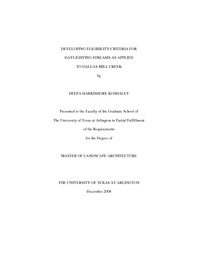| dc.description.abstract | Daylighting is a deliberate act of exposing the full or partial flow of previously buried rivers, creeks and streams into restored surface waterways. Human development has encroached upon natural streams and confined them in concrete channels and pipes, covered them partially or fully, and altered their natural courses. Eventually this has caused reductions in flow capacity, increase in flow velocity, and water pollution, leading to floods, erosion, and loss of natural resources. Stream daylighting is in a developmental phase, meaning that most of the daylighting projects have been undertaken without proper hydrological, geomorphological, and ecological assessment or knowledge of the outcome. Daylighting projects need to be carefully engineered into a storm-water management system.. Few design standards, construction details, and references have been published on daylighting of streams to help professionals assess and plan for the rehabilitation of urban streams. This paper identifies common denominators in the daylighting processes based on a literature search and review of fifteen completed daylighting projects in North America.The study focuses on the issues of stream daylighting surrounding Mill Creek, a buried stream in Dallas, Texas. Historically, Mill Creek--once the longest and deepest creek in the city of Dallas--played an important role in the city's early development. However, over several decades, the creek became an open sewer carrying human and industrial waste. The riparian system which enveloped the creek was removed as the developing urban framework encroached upon the stream. In 1910, the Dallas Park Board authorized city planner George Kessler to prepare a master plan for the city. According to Kessler's plan, parkways were called for alongside Turtle Creek, Mill Creek, and Cedar Creek, all lying within the city limits. Rather than following this plan, however, the City decided in the 1930s to bury Mill Creek in underground storm sewers. Events in the past decade, including violent floods in the residential neighborhoods and Baylor University's medical complex, revealed the extent of the subsurface drainage problems of the historic creek. According to the City's Master Drainage Plan for Mill Creek (2005), partial daylighting has been proposed to mitigate these problems. Preliminary daylighting criteria have been synthesized based on review and analysis of available literature and information. Based on Mill Creek study results using Geographic Information Systems (GIS) and analysis of interviews and correspondence with the city officials and daylighting experts, historical/cultural values and thoroughfares have been established as key considerations for daylighting Mill Creek, The results were based on components or aspects and issues of decision making for daylighting streams, rather than a detailed step-by-step protocol for stream daylighting implementation. Roadways/thoroughfares are a key infrastructure in today's urbanized areas; it is considered important criteria for daylighting streams in highly urbanized areas like Dallas, Texas. Secondly, Mill Creek had played a key role in establishing Dallas as an important transportation and economic center in north-central Texas, besides providing a source of drinking water. Enhanced eligibility criteria for daylighting Mill Creek have been developed by adding these two key criteria to the preliminary criteria. The study has also shown that partial daylighting is feasible in the Mill Creek watershed and would be a better choice than replacing the old and under-capacity drainage system of the Mill Creek watershed. Property values in the Mill Creek watershed will likely increase after daylighting. Stream daylighting offers viable solutions to address the problems of flooding, erosion, and loss of natural resources and provides benefits like improving water quality, reestablishing aquatic/riparian habitat and wildlife corridors, and restoring natural resources. While this research does not suggest daylighting the entire historic run of Mill Creek, it shows the possibility of partial daylighting of the buried creek. It provides the context for selection of potential daylighting sites in Dallas, and can be useful in formulating a city-wide stream-daylighting policy in Dallas. This report will also serve as a reference for future planning efforts in the Mill Creek watershed. | en_US |




